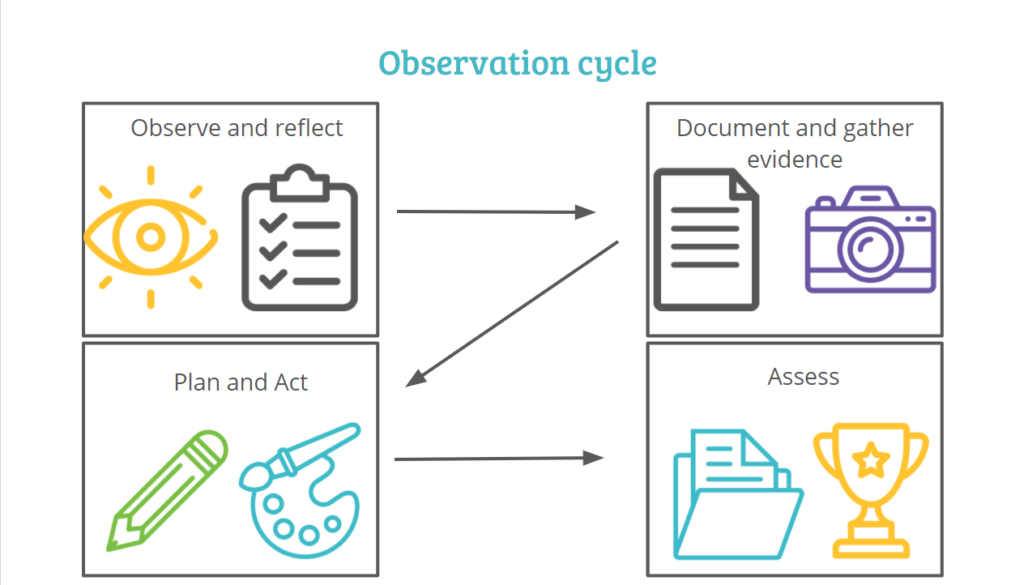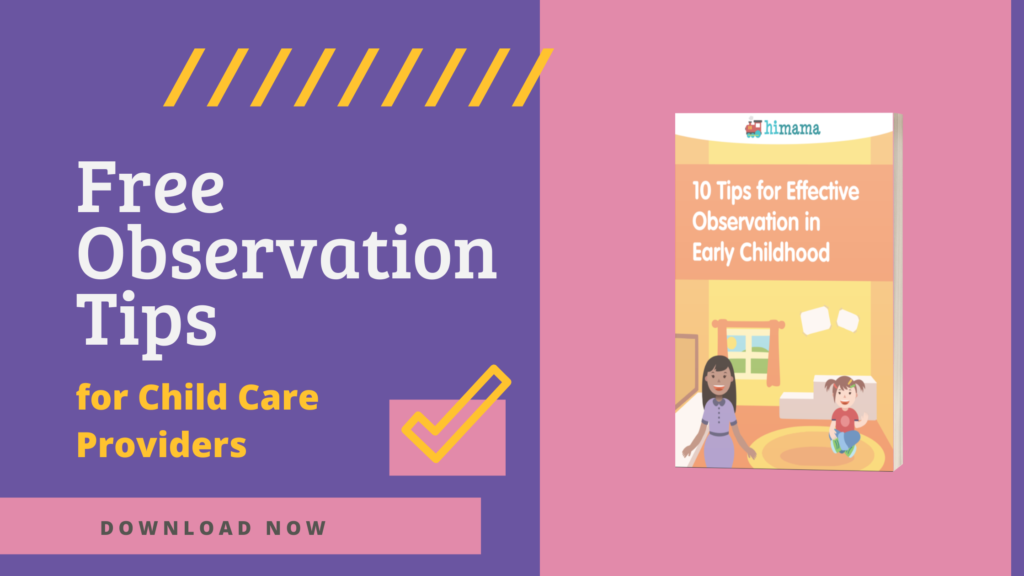Why Is Important to Observing, Documenting, and Assessing to Support Young Children and Families
Observations are function of every twenty-four hour period to day life of an early childhood educator. Most child intendance providers understand the role of observation but practise they understand why it'due south important? Early childhood education [ECE] is non only well-nigh teaching children, it'south about exploration, learning, and observing play. Educators play an of import part in helping children meet developmental milestones and through observation is how educators learn more almost each and every child they piece of work with.
Observation is often seen every bit ane of the virtually elementary, yet constructive methods of assessing young children as they develop. For an early childhood educator, observing a child begins past noting how each child behaves, learns, reacts to new situations, and interacts with others. An educator so takes this information and creates activities to promote growth on skills, document the success of those skills, and and so reflect and assess.
What is ascertainment in early childhood education? 🤔
Ascertainment in ECE is the process of tracking children'southward behavior over a period of time. Through meaningful and detailed documentation, educators are able to meet patterns and plan age-appropriate activities, gain insight into how a child thinks well-nigh the world, and provide opportunities for educators to modify the environs to promote growth and development.
Why do we observe children's development? 🧐
When a teacher sits back and observes a kid within their care, the educator tin then better sympathize the children'southward strengths or weaknesses. Through observations, educators' programming can help brand improvements to the surroundings and facilitate learning.
Ascertainment of a kid's beliefs can:
- Help an educator improve sympathize why a child might exist having challenging behavior
- Identify special needs
- Better sympathise the child
- Allows for documentation of skills
- Shows the kid'southward communication style
- What their interactions with their peers are like
Ascertainment or the process of it has a focus on how – How did the child go in that location vs. than the production the child used. The ascertainment process is very directly forward: Observe and reflect, document and gather evidence, Plan and act, and finally appraise. You only assess over long periods of time. Typically in one case every six months depending on the blazon of assessment yous are using.

What are the types of documentation? 📋
Having evidence of skill growth helps gain better insight into where a child is at. Having meaningful interactions when a kid is playing can allow for the project to continue over long periods of fourth dimension and keeping the child'south interest up.
- Written observations with language samples. Example: Bobby is building with the blocks. He is stacking all the foursquare blocks and then topping off with a triangular block. When I asked Bobby what he was creating his response was "This is my business firm, because it has a bespeak at the elevation"
- Drawings or attempts of writing – catch that picture earlier it ends up in the recycle
- Pictures of constructions – Have a moment to capture that creation before tidy uptime
- Videos – Videos can be so powerful and if you are using digital documentation it's much easier to catch those moments
- Learning stories with directly links to skills – Typically add a film and tagged with a skill from your framework
Observations also assist build on the progress reports – Typically centers will have an ongoing tracking of the kid's skills and development and report back to families. This is the step before going into an assessment.
What practice educators track?🔀
Educators look to assistance grow the child as a whole and want to encourage growth and evolution of skills in all areas. The primary areas of focuses are on:
Cognitive evolution
Concrete development
Social development
Emotional development
Language and literacy evolution
Depending on the style of didactics or curriculum there may be other areas of focus merely these will always be key areas of focus. Each of these areas of development impact one another and when a child is learning and playing
Observations and assessments📓
You've been gathering observations, changing the environment effectually, and providing meaningful activities to promote growth, now what? Well as the children learn more skills and adapt to different situations, you take bear witness gathered to prove this. Through pictures and written observations that you have gathered over time, it's now time to reflect on all this difficult work and appraise. Assessments can't be washed without evidence and observations are a huge slice of evidence. Now there are many different types of assessments you can cull to do, but make sure you have been trained on how to assess properly. Some assessments are every bit simple as a checklist and some require certification. As well, make certain the assessment you utilize is approved to be used in your area and also ties to the values and teaching style of your centre.
Connect with Parents👨👨👧
The final piece to observations is bringing this data dorsum to parents and working with them directly to make sure the child is supported both at home and in the classroom. Having meetings with parents to not only discuss any ongoing issues or issues but as well to plan what the goals are for their kid and understanding the role a teacher plays in a child's life. With a good working relationship with parents, a kid can be very successful.
Tying these all together is no easy task and for many educators, information technology is very time consuming, but it is a very important slice. Many centers accept made the switch to HiMama because of this. Within the app, teachers can tag skills, observe, reverberate, and then assess using piece of work sampling or ounce. All the while sharing updates with families! Today with COVID-nineteen on the doorstep, having open communication with parents is very important every bit many can not come within the middle to observe how the classroom is growing.

Related Posts
- Why Observe Children at Play?
- Types of Child Intendance Observation
- How to Brand Health and Wellness Observations in Early Education
- Kid Care Observation: How Much Documentation is Too Much?
Originally published in January five, 2016. Updated past Ria Simon. Photo Source – University of Alaska.
Earlier Yous Go…
Is your center prepared for today'south childcare expectations?
In 2021, parents are looking for centers that offer digital parental communication, observations and assessments, shared photo and video updates, and contactless check-in and billing.
HiMama is an all-in-one app to aid you with all that, and boost your enrollment! Become a FREE fifteen-infinitesimal bout with us here.
Source: https://www.himama.com/blog/assessing-toddler-development-through-observation/
Post a Comment for "Why Is Important to Observing, Documenting, and Assessing to Support Young Children and Families"